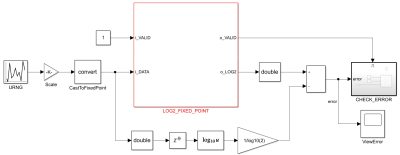Hardware Implementation of Streaming Logarithm Computing Unit for Fixed-Point Data
Main Article Content
Abstract
The work aims to create hardware implementation of the streaming computing unit for logarithm calculation in fixed-point. Logarithms are widely used in telecommunications, particularly in radio intelligence to convert power spectrum values to decibels for further processing of spectrum data, e.g. for radio signals detection, range-finding, or direction-finding. For spectrum analysis of high sampling rate wideband signals, it is expedient to utilize hardware computing units for streaming logarithm calculation, implemented inside FPGA or ASIC chips. The market offers a large amount of IP cores for logarithm calculation in floating point. Floating-point calculation units offer a high dynamic range but also consume a large number of hardware resources that could diminish the maximum clock frequency of devices. In the proposed work, different approaches for logarithm calculating are considered, including CORDIC, Taylor series, and table-based methods. Authors proposed a mathematical model and architecture of streaming computing unit for base 2 logarithm calculation in fixed-point that can be easily adapted to any other base, simply multiplying the result by a constant. The proposed computing unit utilizes a table-based approach and counting leading zeroes in the argument. Based on the mathematical model, the high-level computational model in MATLAB® Simulink® was created. All the components of the mentioned model are compatible with HDL Coder. The proposed MATLAB® Simulink® model is parameterizable, one can set word and fraction width for input/output data, and memory size for table-based part. Using HDL Coder, Verilog HDL implementation for the proposed logarithm computing unit was synthesized. Utilizing HDL Verifier authors created the testbench in Verilog language for the verification of created computing unit on RTL level of abstraction based on reference data collected during simulation in Simulink. Running generated testbench in ModelSim simulator for one million clock cycles proved that there are no differences in operation between the Simulink Model and generated HDL design. The authors were synthesized HDL implementation of the created computing unit in Quartus Prime for the Stratix IV FPGA chip to evaluate the hardware cost of the proposed solution. The developed logarithm calculation unit was compared to the existing CORDIC, Taylor series, and table-based implementations in terms of calculation error and hardware costs. Additionally, for comparison purposes the authors created a hardware implementation for the base 2 logarithm calculation unit in a single-precision floating-point. During the evaluation of the calculation error, the double-precision floating-point logarithm computing unit from Simulink was chosen as the source for reference results. The comparison showed that created computing unit provides less calculation error compared to the existing fixed-point solutions, requires fewer hardware resources for implementation and can operate on higher clock frequencies. All the created models and source codes are open for utilization and can be downloaded from GitHub.
Article Details

This work is licensed under a Creative Commons Attribution 4.0 International License.
Authors who publish with this journal agree to the following terms:- Authors retain copyright and grant the journal right of first publication with the work simultaneously licensed under a Creative Commons Attribution License that allows others to share the work with an acknowledgement of the work's authorship and initial publication in this journal.
- Authors are able to enter into separate, additional contractual arrangements for the non-exclusive distribution of the journal's published version of the work (e.g., post it to an institutional repository or publish it in a book), with an acknowledgement of its initial publication in this journal.
- Authors are permitted and encouraged to post their work online (e.g., in institutional repositories or on their website) prior to and during the submission process, as it can lead to productive exchanges, as well as earlier and greater citation of published work (See The Effect of Open Access).
References
Demmel, F. (2009). Practical Aspects of Design and Application of Direction-Finding Systems. In Classical and Modern Direction-of-Arrival Estimation (pp. 53–92). Elsevier. DOI: 10.1016/B978-0-12-374524-8.00008-8
C. Park, D. Kim, "The Fast Correlative Interferometer Direction Finder using I/Q Demodulator," 2006 Asia-Pacific Conference on Communications, Busan, 2006, pp. 1-5, DOI: 10.1109/APCC.2006.255915
A. M. Mansour, A. M. El-Sawy, M. S. Aziz, A. T. Sayed, "A New Hardware Implementation of Base 2 Logarithm for FPGA," International Journal of Signal Processing Systems, vol. 3, no. 2, pp. 177-182, Dec. 2015. DOI: 10.12720/ijsps.3.2.177-182
Implement Fixed-Point Log2 Using Lookup Table,” 2020. [Online]. Available: https://www.mathworks.com/help/fixedpoint/ug/implement-fixed-point-log2-using-lookup-table.html [Accessed 16, May 2020]
H. Hassler, N. Takagi, "Function evaluation by table look-up and addition," in Proceedings of the 12th Symposium on Computer Arithmetic, Bath, UK, 1995, pp. 10-16, DOI: 10.1109/ARITH.1995.465382
D. D. Sarma, D. W. Matula, "Measuring the accuracy of ROM reciprocal tables," in IEEE Transactions on Computers, vol. 43, no. 8, pp. 932-940, Aug. 1994, DOI: 10.1109/12.295855
D. K. Kostopoulos, “An algorithm for the computation of binary logarithms,” IEEE Transactions on Computers, vol. 40, no. 11, Nov. 1991. DOI: 10.1109/12.102831
“A way to calculate logarithm with a base of two,” 2019. [Online]. Available: https://habr.com/ru/post/469327/ [Accessed 16, May 2020]
P. K. Meher, J. Valls, T. Juang, K. Sridharan, K. Maharatna, "50 Years of CORDIC: Algorithms, Architectures, and Applications," in IEEE Transactions on Circuits and Systems I: Regular Papers, vol. 56, no. 9, pp. 1893-1907, Sept. 2009, DOI: 10.1109/TCSI.2009.2025803
L. Bangqiang, H. Ling, Y. Xiao, "Base-N logarithm implementation on FPGA for the data with random decimal point positions," 2013 IEEE 9th International Colloquium on Signal Processing and its Applications, Kuala Lumpur, 2013, pp. 17-20, DOI: 10.1109/CSPA.2013.6530006
R. D. Yershov, "A Scalable VHDL-Implementation Technique of the Priority Encoder Structure into FPGA," 2018 IEEE 38th International Conference on Electronics and Nanotechnology (ELNANO), Kiev, 2018, pp. 727-732, DOI: 10.1109/ELNANO.2018.8477465
H. Warren, Hacker's Delight, Addison-Wesley, 2012. ISBN: 978-0-321-84268-8
I. Korotkyi, “Source code for the proposed Log2 hardware accelerator,” 2020. [Online]. Available: https://github.com/KorotkiyEugen





